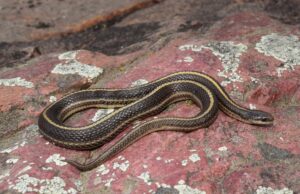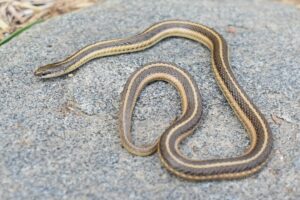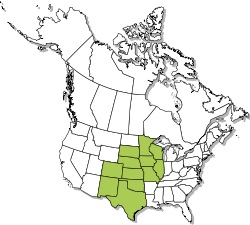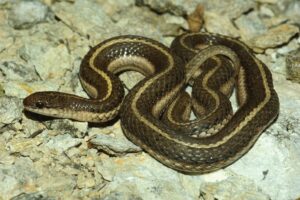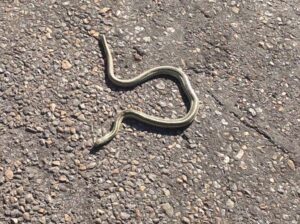The lined snake is a small, non-venomous, fossorial snake that is the sole member of the genus Tropidoclonion. They are also known as common snakes, grass snakes, line snakes, ribbon snakes, dwarf garter snakes, striped snakes, streaked snakes, and swamp snakes.
Despite appearing similar to several snakes, including garter snakes, they can be identified by the half-moon markings on their underside. Although these snakes are primarily nocturnal, they can be seen basking during the day in the spring and every fall.
Scientific Classifications
- Suborder:Serpentes
- Family:Colubridae
- Genus:Tropidoclonion
- Species:T. lineatum
Conservation Status
Subspecies
It has four subspecies:
- Central Lined Snake (Tropidoclonion lineatum annectens)
- Northern Lined Snake (Tropidoclonion lineatum lineatum)
- Mertens’ Lined Snake (Tropidoclonion lineatum mertensi)
- Texas Lined Snake (Tropidoclonion lineatum texanum)
Description
Size
Lined snakes are 8-15 inches (20–38 cm) long. They can grow to a maximum length of 21 inches (53 cm).
Color and Appearance
These snakes are of greyish brown color, with a prominent tan or yellow stripe running down the middle of the back from head to tail. Similar streaks, one down each side on scale rows 2 and 3, also exist.
They have white bellies with two rows of dark grey, half-moon spots on the midline. Their head is narrow, and their eyes are small. On their midbody, one can observe 19 rows of keeled dorsal scales and only 5 or 6 supralabial scales.
Are They Dangerous to Humans
These snakes are non-venomous and are not dangerous to humans. They seldom bite when handled.
Lined Snakes at a Glance
Distribution
Lined snakes occur in the central United States, with a range spanning from Illinois to Texas.
Habitat
They can live in various habitats such as native prairies, empty lots in suburbs and towns, meadows, along highways, near old trash dumps, and in grasslands with soft, moist soil.
In the daytime, they remain hidden in rocks, logs, and debris from where they come out at night. They are generally active from April through October, while they stay in hibernation for the rest of the year.
Lifespan
The lifespan of lined snakes is unknown, but garter snakes, which are closely related to them, live 3 to 10 years. Their short lifespan is due to habitat loss and a high mortality risk on busy roads.
Predators
Lined snakes are threatened by different types of mammals and birds who prey on them, such as birds of prey, bullfrogs, or kingsnakes,
Their cryptic coloration protects them from predators. As they are semi-fossorial and mostly live beneath the surface, it is difficult for predators to find them.
When attacked or captured, they emit a foul-smelling musk from the glands at the base of their tails.
Diet
Lined snakes primarily eat earthworms. That is why they are most active at night or after a rainstorm when earthworms are abundant. Their secondary diet includes snails, slugs, sow bugs, and soft-bodied insects.
Reproduction
They are ovoviviparous. Autumn is the mating season of these snakes. Females can produce 2-12 babies in one litter, with an average of 7-8 hatchlings each time. The newborns are 4-4¾ in. (10-12 cm) long at birth and are born between July and August.
The mothers give nutrients and protection to the offspring inside their bodies until birth. After birth, they become fully independent and do not require parental care.
Females acquire reproductive maturity when they are two years old, whereas males become sexually mature at one year of age.
Similar Species
Common Garter Snake
Common garter snakes are found in North America and resemble lined snakes to a large extent. Their less uniform appearance and black markings on the lips differentiate them from lined snakes. Like lined snakes, they do not have the double row of half moons on their belly.
Plains Garter Snake
These snakes are similar in appearance to common garter snakes, with the only difference being the stripes on the sides of their bodies.
Smooth Earth Snake
Smooth earth snakes are found in the eastern United States. They have a less prominent stripe down the back.
Western Ribbon Snake
It has an orange or red stripe down the back, whereas the lined snakes have tan-yellow stripes.
Graham’s Crayfish Snake
Graham’s crayfish snakes are found in the central United States. They have a less prominent stripe down the back.
Source
mnherps.com, sdherps.org, mdc.mo.gov

